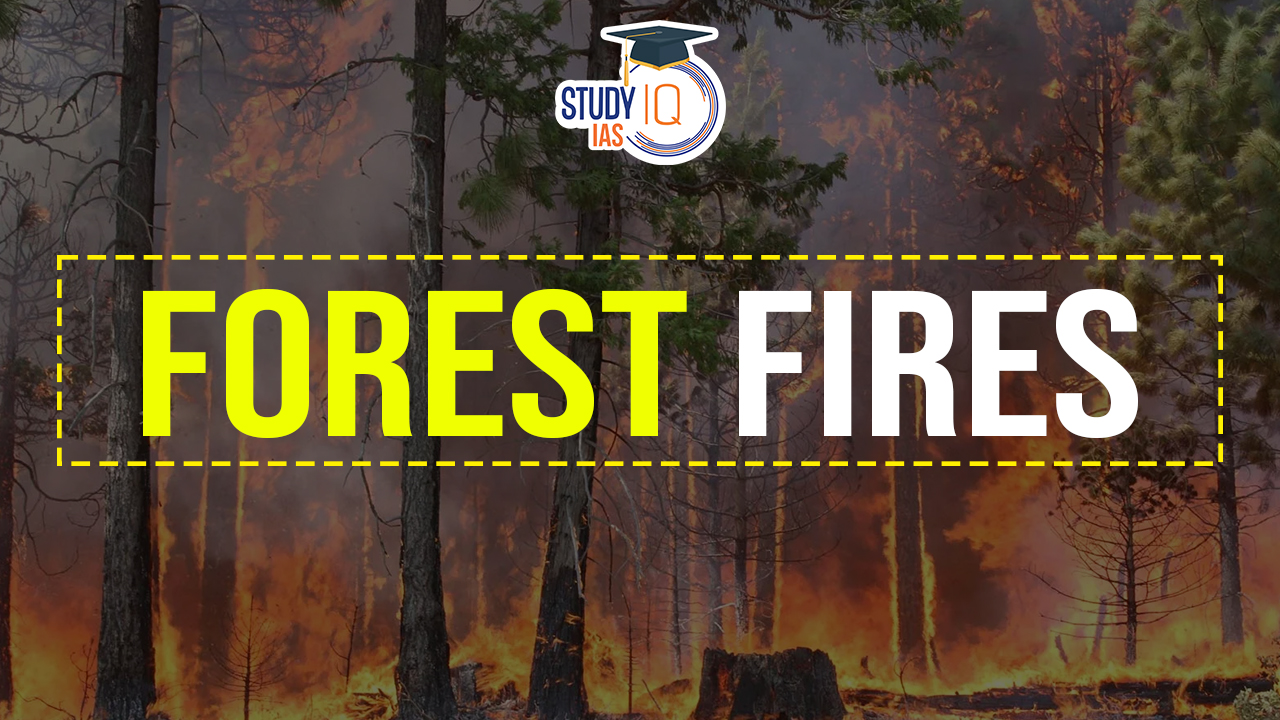Table of Contents
Context:
- Uttarakhand’s forest fires have caused at least five deaths and threaten populated areas like Nainital.
- Air Force firefighting is hampered by poor visibility.
- Himachal Pradesh (H.P.) is experiencing extensive forest fires, with 1,684 incidents reported since last two months, resulting in damage to 17,471 hectares of forest land and significant wildlife losses.
More in News
- Experts link the fires to increased heat and black carbon emissions, which negatively affect water systems and air quality.
- IAF joined the Tamil Nadu Government’s efforts to tackle forest fires in the Nilgiris. It is using the “Bambi Bucket”, deploying a Mi-17 V5 helicopter to dump 16,000 litres of water on the fires.
| Fact |
| Between 2001 and 2023, H.P. lost 957 hectares of tree cover to fires and 4.37 thousand hectares to other causes. |
Forest Fire Season
In India
- Forest Fire Season: Forest fire season in India spans from November to June, with the highest frequency of fires observed from February as summer approaches. April and May are the peak fire months.
- Vulnerability: According to the 2019 India State of Forest Report (ISFR), over 36% of India’s forest cover is prone to frequent fires, including 4% ‘extremely prone’ and 6% ‘very highly’ prone areas.
Global Context
- Globally, around 3% of the total forest area, or about 98 million hectares, was affected by fires in 2015, mainly in tropical regions.
Where do the most forest fires in India occur?
- According to the FSI, severe fires break out in dry deciduous forests, while evergreen, semi-evergreen, and montane temperate forests are comparatively less prone to fires.
- Severe fires often occur in the dry deciduous forests of Northeast India, Odisha, Maharashtra, Jharkhand, Chhattisgarh, and Uttarakhand.
- For Example: In March 2023, large bushfires raged in Goa, triggering an investigation into whether they were “man-made”.
- In 2021, a series of forest fires broke out in Uttarakhand, Himachal Pradesh, Nagaland-Manipur border, Odisha, Madhya Pradesh, and Gujarat, including in wildlife sanctuaries.
We’re now on WhatsApp. Click to Join
Deeper Issues and Historical Context of Forest Fires in India
- 95% of forest fires in India are caused by human activities.
- In Uttarakhand, summer accumulations of pine needles historically contributed to fires, which were ecologically beneficial for regenerating forests.
- Currently, fires are often started by land clearing or accidental causes such as discarded cigarettes.
- The usual fire season from February to June is starting earlier, with a notable increase in fire alerts in January, coinciding with unusually dry conditions.
- In 2023, the monsoon was deficient, and the state experienced a 70% rainfall shortage in November and December.
- April was the driest in five years, exacerbating the vulnerability of the forests to fire.
Government Response and Measures
- The state government attributes the fires to human activities and has implemented a temporary ban on burning fodder and solid waste near forests.
- Urban bodies are instructed to enforce these bans.
Long-Term Strategies and Needs
- The forest department has created firelines to control the spread of fires.
- There is a pressing need for advanced weather prediction systems, satellite monitoring, and training for local communities as first responders.
- Given Uttarakhand’s susceptibility to natural disasters like floods and landslides, attributed to poor policy decisions, the state requires robust climate-proofing initiatives.
Forest Fires in 2024: Data and Analysis
Fire Prone Areas
- Highest fire incidents reported in Mizoram, Manipur, Assam, Meghalaya, Maharashtra.
- Southern states – Andhra Pradesh, Karnataka, and Tamil Nadu – have also seen fire incidents.
- Evergreen and semi-evergreen forests of South India are generally less vulnerable.
- However, Tamil Nadu has faced wildfires in recent years.
Causes of Forest Fires
- Human-made: Discarded cigarettes, campfires, burning debris.
- Natural: Lightning is the most common cause.
- Forest fires in the Himalayas typically occur during the pre-monsoon summer period, exacerbated by moisture stress and reduced snowmelt water.
- The pre-monsoon season’s moisture conditions, influenced by rainstorms, are critical in determining the severity of these fires.
- Human activities, such as unattended campfires and discarded cigarettes, also contribute to the problem.
- These fires are a significant source of pollutants, including black carbon, which accelerates glacier melt in the Himalayas and negatively affects the regional climate.
- Faulty forestry practices and a utilitarian perspective on forest management, which excludes community participation, are primary causes of these fires.
Factors Contributing to Spread (Especially in South India)
- Weather conditions:
- Hot and dry temperatures
- Above-normal day temperatures
- Clear skies
- Calm winds
- Early availability of dry biomass due to hot February (hottest since 1901)
- Aridity: Most districts in southern India are classified as “mildly arid” with no rain and high temperatures.
- Excess Heat Factor (EHF): A high chance of heat waves is predicted in western Andhra Pradesh and Karnataka.
Historical Transformation of Himalayan Forests
- The Himalayan forests have undergone significant changes over the last two centuries.
- The construction of railways in the 1850s marked a critical shift, driven by the need to market British goods and provide profitable avenues for British capital.
- From 1853 to 1910, the construction of approximately 80,000 km of railway track led to extensive deforestation and the loss of customary rights for local people.
- During this period, the demand for railway sleepers led to the exploitation of Deodar trees, and the expansion of Chir pine areas for timber and resin production.
- Between 1910 and 1920, the number of trees tapped for resin increased dramatically from 260,000 to over 2.1 million.
- Chir pine forests, valued commercially for timber and resin, replaced Banj oak forests, which were ecologically beneficial for moisture retention and water spring maintenance.
|
Facts |
| Current Forest Composition and Vulnerability: Today, Chir pine forests cover more than 17.8% of H.P.’s 37,033 square kilometres of forest area. These forests are particularly vulnerable to forest fires. |
Recommended Actions
- Democratisation of Forest Management: Involve local communities in forest management processes.
- Restore traditional forest rights for extracting wood, timber, and fodder.
- Community Rights and Development Projects: Uphold the rights of local communities under Schedule V of the Indian Constitution, requiring their assent for development activities.
- Address the ease with which forests are diverted for large projects such as hydro power generation and road construction.
- Mixed Forestry and Scientific Knowledge: Promote mixed forestry to replace vulnerable pine trees with more resilient species.
- Integrate scientific and community knowledge for participatory forest management.
- Water Conservation: Implement check dams and other measures to revive water springs.
- Environmental Services and Financial Support: Create environmental services at the village level.
- Articulate the need for support from the 16th Finance Commission, apart from disaster mitigation funds.
Connection between Climate change and Forest Fires
- Global warming: Climate change and global warming have increased temperatures, leading to longer dry spells. This facilitates the drying of vegetation, making them vulnerable.
- Decline in duration of rainy season: Even though the intensity of rains has increased, it is concentrated within a short period. An increase in the dry season has allowed vegetation to turn into a tinder box.
- Increase in lightning: Studies have indicated that there will be more frequent incidences of lightning due to climate change. Such lightning incidents can trigger forest fires.
- Heatwaves: Heatwave incidents have drastically increased across the world because of climate change. Heatwave conditions are optimal for forest fire incidents.
Forest Fire Management under National Forest Policy
- The policy aims to prepare a strong database/network on forest fires and evolve an appropriate method to deal with the forest fire situation in more effective manner.
- Under the policy, an Early Warning Fire Forecasting System utilizing satellite data and a Fire Danger Rating System for the early detection of forest fire has been introduced.
Some actions suggested under the policy
- Preventive actions: A preventive program consisting of zoning, danger rating, early warning and real-time monitoring must be developed and implemented.
- Inter-agency coordination: The Forest department needs to coordinate with the National Remote Sensing Agency, Forest Survey of India, the Meteorological Department, All India Radio and State-owned television to plan their actions during the fire season.
- Increase vigilance: Vigilance must be increased in vulnerable areas. For that adequate number of firewatchers must be appointed.
- Communication network: Accessibility to vulnerable areas must be enhanced to enable quick transport of humans and materials from one area to another.
- Awareness campaign: An awareness campaign involving schools, Joint Forest Management (JFM) committees, NGOs and other groups must be initiated to handle fire damage, prevention, detection communication and suppression.
- Training: Training must be provided to fire managers, including trainers at JFM unit levels. This will empower them to take effective actions during forest fires.


 Rare Earth Elements, Metals, Magnets, Ap...
Rare Earth Elements, Metals, Magnets, Ap...
 Places in News for UPSC 2025 for Prelims...
Places in News for UPSC 2025 for Prelims...
 Indian Continental Plate is Splitting Ap...
Indian Continental Plate is Splitting Ap...





















